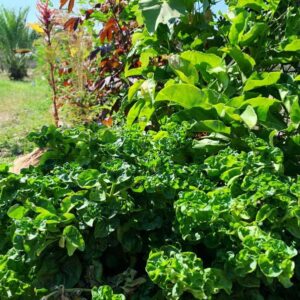Black Pepper PLANT – Untreated & Heirloom – Perennial Pepper Spice Plant – Piper nigrum
Black Pepper – Piper nigrum is a flowering vine that is grown for the peppercorns which are the fruit of the plant. It is an attractive ornamental plant that can be grown inside in colder climates or outside if the temperature doesn’t go below 0°C. The flowers are pollinated by rain so it is important to imitate this while the vine is flowering. Black pepper has been around for a long time, not only in cooking to spice food but also in traditional medicine to cure and prevent various human illnesses including “age-related neurological disorders (Balakrishnan et.al. 2023)” – link to the scientific article in the references section below.
The plant you buy is grown from a cutting by Ewa from the mother plant.
Interesting facts: “Black pepper, the fruit of Piper nigrum L. in the family Piperaceae, is an important food spice that has long been used in traditional medicine to treat various human diseases. Consumption of black pepper and black pepper-enriched products is associated with numerous health benefits due to its antioxidant, antidiabetic, anti-obesity, antihypertensive, anti-inflammatory, anticancer, hepatoprotective, and neuroprotective properties. (Balakrishnan et.al. 2023)” – link to the article in the references section below.
For the different colours of the peppercorns: Black peppercorn is an underripe peppercorn that has been harvested, blanched, and dried. The white peppercorn is the ripened berry without the outer skin. The green peppercorns are harvested when they are underripe and dried or freeze-dried. Peppercorns that have been given time to fully ripen and turn red are known as red peppercorns.
Planting and growing tips:
- Give it a good drink and place it in a half-shade position out of the wind.
- Leave it in the original pot for a few days until it recovers from the journey.
- Re-pot or plant into the ground at the latest when the roots start to come out of the bottom holes.
- Watering straight after planting is essential! From then on as required.
- It doesn’t like to sit in water so a well-drained position is best. All our edibles grow happily and quickly in slightly raised garden beds.
- It does best in partial shade and in many types of soil, however, the better the soil, the quicker and better the plant will grow.
- Grow in your garden or a pot.
Additional notes:
- The potted plant in the image is just an example of what your plant can look like, and this is the mother plant of the baby plant you get. The price is for one young plant in a small pot from the mother plant, naturally grown with lots of love in my permaculture food forest in Pacific Haven QLD Australia. Sending within Australia only, not to NORFOLK ISLAND, NT, SA, TAS, or WA. Pick up by appointment only.
- Most of our nursery plants grow in a semi-shade. Introducing them to the sun slowly before replanting to their permanent position will promote healthy growth.
- Do your research before trying any new foods. Please also note our disclaimer in the footer of this page.
References: Balakrishnan, R., Azam, S., Kim, S., & Choi, K. (2023). Neuroprotective Effects of Black Pepper and Its Bioactive Compounds in Age-Related Neurological Disorders. Aging and Disease, 14(3), 750-777. https://doi.org/10.14336/AD.2022.1022









